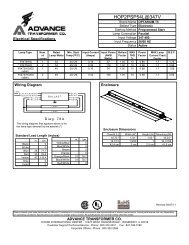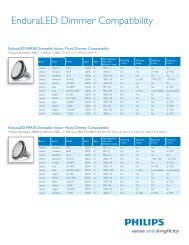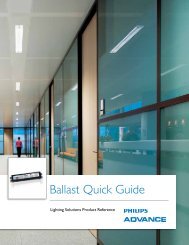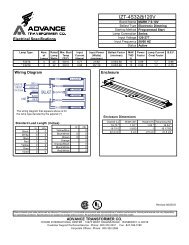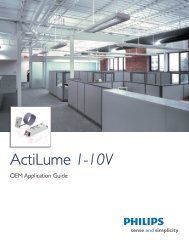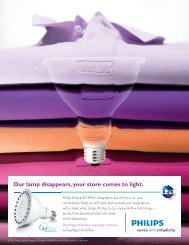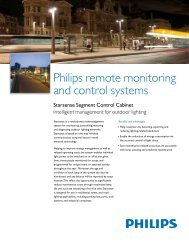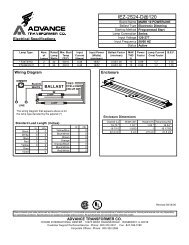Lamp Specification and Application Guide 2008 ... - Philips Lighting
Lamp Specification and Application Guide 2008 ... - Philips Lighting
Lamp Specification and Application Guide 2008 ... - Philips Lighting
You also want an ePaper? Increase the reach of your titles
YUMPU automatically turns print PDFs into web optimized ePapers that Google loves.
High Intensity Discharge 121–148 Solid State <strong>Lighting</strong> 149–156 Specialty 157–177 Additional Information 178–189<br />
HIGH INTENSITY DISCHARGE LAMPS<br />
Warnings, Cautions <strong>and</strong> Operating Instructions<br />
WARNINGS, CAUTIONS AND OPERATING INSTRUCTIONS for Safety Lifeguard Metal Halide <strong>Lamp</strong>s<br />
(Open or Enclosed Fixtures)<br />
Warnings, Cautions <strong>and</strong> Operating Instructions<br />
“WARNING: This lamp should self extinguish<br />
R within 15 minutes after outer envelope is broken or<br />
punctured. If such damage occurs, turn off <strong>and</strong> remove<br />
lamp to avoid possible injury from hazardous shortwave<br />
ultraviolet radiation.” This lamp complies with FDA<br />
radiation performance st<strong>and</strong>ard 21 CFR subchapter J.<br />
(USA:21CFR 1040.30 Canada:SOR/DORS/80-381)<br />
This lamp should not be used on dimmers <strong>and</strong> is not<br />
warranted if used on dimming systems.<br />
If the outer bulb is broken or punctured, turn off<br />
at once <strong>and</strong> replace the lamp to avoid possible<br />
injury from hazardous short wave ultraviolet<br />
radiation. Do not scratch the outer bulb or<br />
subject it to pressure as this could cause the<br />
outer bulb to crack or shatter. A partial vacuum<br />
in the outer bulb may cause glass to fly if the<br />
envelope is struck.<br />
WARNING: The arc-tube of metal halide lamps<br />
are designed to operate under high pressure <strong>and</strong> at<br />
temperatures up to 1000º C <strong>and</strong> can unexpectedly<br />
rupture due to internal or external factors such as a<br />
ballast failure or misapplication. If the arc-tube ruptures<br />
for any reason, the outer bulb may break <strong>and</strong> pieces of<br />
extremely hot glass might be discharged into the<br />
surrounding environment. If such a rupture were to happen,<br />
THERE IS A RISK OF PERSONAL INJURY,<br />
PROPERTY DAMAGE, BURNS AND FIRE.<br />
Certain lamps that will retain all the glass<br />
particles should inner arc-tube rupture occur<br />
are commercially available from <strong>Philips</strong><br />
<strong>Lighting</strong> Company.<br />
RELAMP FIXTURES AT OR BEFORE THE END<br />
OF RATED LIFE. Allowing lamps to operate until<br />
they fail is not advised <strong>and</strong> may increase the<br />
possibility of inner arc tube rupture.<br />
CAUTION: TO REDUCE THE RISK OF PERSONAL<br />
INJURY, PROPERTY DAMAGE, BURNS AND FIRE<br />
RESULTING FROM AN ARC-TUBE RUPTURE<br />
THE FOLLOWING LAMP OPERATING<br />
INSTRUCTIONS MUST BE FOLLOWED:<br />
LAMP OPERATING INSTRUCTIONS:<br />
1. Turn off lamps at least once a week for at least<br />
15 minutes in systems which are operating on a<br />
continuous basis (24 hours/day-7days/week). FAILURE<br />
TO TURN OFF LAMPS FOR THE MINIMUM<br />
RECOMMENDED TIME MAY INCREASE THE<br />
POSSIBILITY OF AN INNER ARC-TUBE RUPTURE.<br />
2. RELAMP FIXTURES AT OR BEFORE THE END OF<br />
RATED LIFE. Allowing lamps to operate until they fail is<br />
not advised <strong>and</strong> may increase the possibility of inner arc<br />
tube rupture.<br />
3. If operated other than vertical ± 15º, use only<br />
in an enclosed fixture capable of withst<strong>and</strong>ing<br />
particles of glass having temperatures up<br />
to 1000º C.<br />
4. Before lamp installation/replacement, shut power off<br />
<strong>and</strong> allow lamp <strong>and</strong> fixture to cool to avoid electrical<br />
shock <strong>and</strong> potential burn hazards.<br />
5. Use only auxiliary equipment meeting <strong>Philips</strong><br />
<strong>and</strong>/or ANSI st<strong>and</strong>ards. Use within voltage limits<br />
recommended by ballast manufacturer.<br />
A. Operate lamp only within specified limits<br />
of operation.<br />
B. For total supply load refer to ballast manufacturers<br />
electrical data.<br />
6. Periodically inspect the outer envelope. Replace any<br />
lamps that show scratches, cracks or damage.<br />
7. If a lamp bulb support is used, be sure to insulate the<br />
support electrically to avoid possible decomposition of<br />
the bulb glass.<br />
8. Protect lamp base, socket <strong>and</strong> wiring against moisture,<br />
corrosive atmospheres <strong>and</strong> excessive heat.<br />
9. Time should be allowed for lamps to stabilize in color<br />
when turned on for the first time. This may require<br />
several hours of operation, with more than one start.<br />
<strong>Lamp</strong> color is also subject to change under conditions<br />
of excess vibration or shock <strong>and</strong> color appearance may<br />
vary between individual lamps.<br />
10. <strong>Lamp</strong>s may require 10 to 20 minutes to re-light if<br />
there is a power interruption.<br />
11. Take care in h<strong>and</strong>ling <strong>and</strong> disposing of lamps. If an arc<br />
tube is broken, avoid skin contact with any of the<br />
contents or fragments.<br />
12. Do not use this lamp:<br />
A. In a fixture that contains a Pulse Start metal<br />
halide ballast.<br />
B. In a fixture that is specifically designed for use with<br />
Pulse Start metal halide lamps. Operation of<br />
these lamps on Pulse Start Metal Halide<br />
systems may increase the chance of an<br />
outer bulb rupture <strong>and</strong> pieces of<br />
extremely hot glass might be discharged<br />
into the surrounding environment. If such a<br />
rupture were to happen, THERE IS A RISK<br />
OF PERSONAL INJURY, PROPERTY<br />
DAMAGE, BURNS AND FIRE.<br />
WARNINGS, CAUTIONS AND OPERATING INSTRUCTIONS for Mini WhiteSON <strong>and</strong><br />
WhiteSON High Pressure Sodium <strong>Lamp</strong>s<br />
Warnings, Cautions <strong>and</strong> Operating Instructions<br />
“WARNING: These lamps must be operated in<br />
fixtures designed for use with High Pressure Sodium<br />
lamps. The fixture wattage rating must match the wattage<br />
indicated on the outer glass bulb. Do not scratch the<br />
outer bulb or subject it to pressure as this could cause<br />
the outer bulb to crack or shatter. A partial vacuum in the<br />
outer bulb may cause glass to fly if the glass is struck.<br />
Operating the lamp improperly may result in<br />
PERSONAL INJURY, PROPERTY DAMAGE,<br />
BURNS AND FIRE.<br />
1. If the outer glass bulb is broken, shut off power<br />
immediately <strong>and</strong> remove the lamp after it has cooled.<br />
2. Use only auxiliary equipment meeting <strong>Philips</strong><br />
<strong>and</strong>/or ANSI st<strong>and</strong>ards. Use within voltage limits<br />
recommended by ballast manufacturer.<br />
A. Operate lamp only within specified limits of operation.<br />
B. For total supply load refer to ballast manufacturers<br />
electrical data.<br />
C. Operate Mini WhiteSON lamps only on approved<br />
electronic ballasts.<br />
3. Protect lamp base, socket <strong>and</strong> wiring against moisture,<br />
corrosive atmospheres <strong>and</strong> excessive heat.<br />
4. Replace the lamp if the outer glass bulb has been<br />
scratched, cracked or damaged in any way.<br />
5. If a lamp bulb support is used, be sure to insulate<br />
the support electrically so as to avoid possible<br />
decomposition of the bulb glass.<br />
6. Do not use this lamp in a fixture which redirects a<br />
substantial portion of the energy toward the arc tube<br />
<strong>and</strong> its immediate vicinity, as this may lead to very early<br />
lamp failure.<br />
7. Take care in h<strong>and</strong>ling <strong>and</strong> disposing of lamps. If arc tube<br />
is broken, avoid skin contact with any of the contents<br />
or fragments.<br />
8. The arc tube of this lamp contains sodium <strong>and</strong><br />
mercury. Dispose of in accordance with federal, state<br />
<strong>and</strong> local requirements.<br />
9. It is possible that the light color will suddenly change.<br />
After some time the lamp will regain its old color.<br />
10. In order to prevent damage to the ballast, the lamp<br />
should be replaced as quickly as possible at the end of<br />
its lifetime (lamp color turns yellow, lamp flickers <strong>and</strong><br />
fails to start).<br />
11. For Mini WhiteSON lamps, after 10,000 hours of<br />
burning the light color will become yellow. The lamp<br />
must then be replaced.<br />
12. For WhiteSON lamps, after 7,500 hours of burning<br />
the light color will become yellow. The lamp must then<br />
be replaced.<br />
<strong>Philips</strong> <strong>Lighting</strong> Company SAG100 <strong>2008</strong>–2009 147





